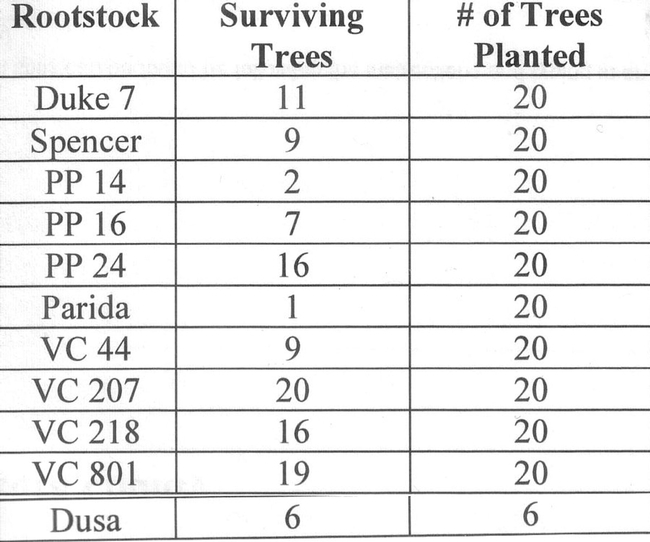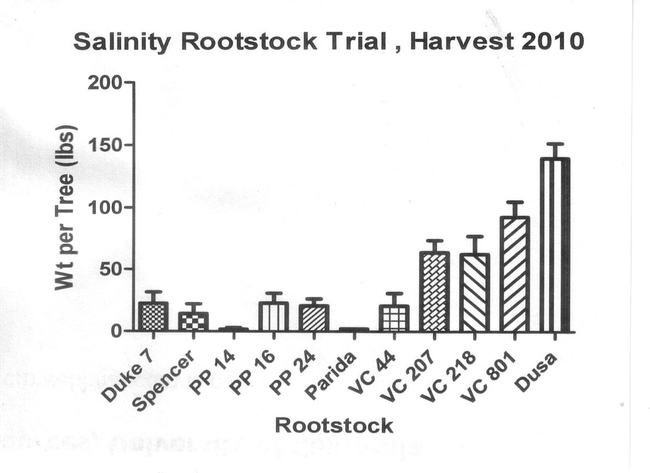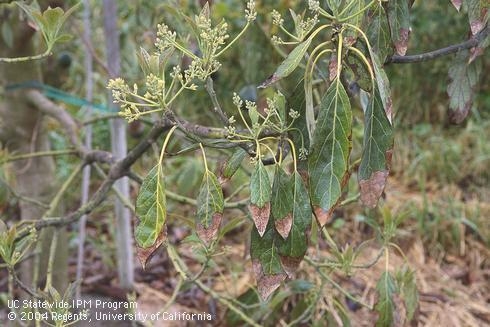
Posts Tagged: rootstocks
COMPARISON OF ‘PIXIE’ MANDARIN GROWTH ON FIVE DIFFERENT ROOTSTOCKS
The rootstocks ‘Bitters', ‘Carpenter' and ‘Furr citrandarins were developed at the USDA Date and Citrus Station in Indio, California. Having mandarin genetics with different horticultural properties and being more tolerant of calcareous soils than some other commonly used rootstocks, their effect on ‘Pixie' mandarin is being evaluated. These three are being compared to the mildly dwarfing ‘C-35' rootstock and to the standard sized ‘Citrumelo' to see how their growth might be used to control tree size, also to see how well they do in an alkaline soil. In 2014, five of each of the rootstock/'Pixie' combinations were planted in randomized blocks at two different sites on mildly alkaline soils (pH 7.3 -7.8) in the Ojai, CA area. Trees were monitored for growth on a yearly basis. At both sites ‘Citrumelo' is the largest in height with the greatest shoot length. All three of citrandarins are smaller than ‘C-35” at both sites. Shoot length is the shortest for ‘Bitters', ‘Carpenter' and ‘C-35' at both sites. At the site with the highest soil pH (7.8), two of the five ‘Bitters' show iron and zinc chlorosis. The only trees to do so. This trial will be monitored for another five years to evaluate their performance. Growth characteristics on other varieties of citrus, such as orange and lemon will probably be the same.
Photo: A young Pixie on Bitters.

c 50
Advances Against HLB
University of Florida research Jude Grosser has been working with a new breeding technique that creates tetraploid rootstocks that are showing significantly improved resistance to Huanglongbing. This is done with conventional breeding and is not based on genetic engineering. He takes citrus rootstocks that have shown some resistance but because of their genetic makeup, it has not be possible to interbreed them. This new technique permits these crosses that were before not possible. He and his group have created new rootstocks that are now being field trialed.
http://ashs.org/abstracts/2013/abstracts13/abstract_id_14201.html
Also on another front, Richard Lee and Manjunath Keremane at the USDA Citrus Germplasm Repository in Riverside have been working with University of Hawaii and a private company – Diagenetix – to develop a field test for identifying HLB infected psyllids. LAMP (loo-mediated isothermal amplification) is a faster, cheaper method than the traditional PCR (polymerase chain reaction) method. It would allow for rapid identification of infected psyllids and a more rapid identification of a potential quarantine area. Conventional PCR would still need to be performed to legally identify infected insects. The technology has been used on other disease organisms such as powdery mildew in grape and bacterial infections in stone fruit trees. Literally anything that carries DNA can be identified by this new technique.
http://www.agnet.org/htmlarea_file/library/20110706164834/ac2007k.pdf

ACP adult and nymph
Avocado rootstocks
I got a call yesterday about yellowing avocados. They are on Dusa rootstock which is very tough when it comes to root rot, but cannot handle wet feet. It turns out that this area is one where the grower cannot order water on demand, but must take it when the water company will deliver. So the poor trees get drowned and then go through drought. This sensitive rootstock is not the right one for this area. Many of the root rot resistant rootstocks have some sensitivity to salt, wet, crown rot, whatever, which brings up the question, if we have phosphites, what about the old rootstocks? Barr-Duke, Duke 7 and Borchard have some very attractive qualities: they are tough and can handle things like salinity and drought and are good producers in the absence of root rot. With phosphites now, they can muscle through root rot. Should we reconsider them? Of course, if you are an organic grower, you need to stick with the most root rot resistant selections. And it is also important to remember that the best line of defense against root rot is proper irrigation, which is the leading problem for root rot.

Copy of avocado irrigation
Decline of Oranges and Mandarins with Trifoliate and Citrange Rootstocks in the San Joaquin Valley of California
In 1985, H. Schneider and J. Pehrson published an article documenting a decline of Frost Nucellar navel oranges on a number of trifoliate rootstocks (H. Schneider and J.E. Pehrson, Jr. 1985. Decline of navel orange trees with trifoliate rootstocks. California Agriculture. Sept. – Oct. 1985 p. 13-16)
http://ucce.ucdavis.edu/files/repositoryfiles/ca3909p13-62889.pdf
In this decline, which began in the 1970s, trees began demonstrating symptoms when they were 15 to 20 years-old. Affected trees showed leaf discoloration, some defoliation, twig dieback and subnormal growth. They describe how some declining orchards were removed and, in others, individual trees were removed and replanted. Schneider and Pehrson concluded the following: “disorganized phloem and cambial tissues at the budunion proliferate into a tongue like wedge that protrudes from the inner side of the bark. Affected tissue acts as a girdle and is presumed to be responsible for the decline of the trees.” In this article, Schneider and Pehrson provide excellent micrographs illustrating what was occurring at the budunion. However, the actual cause of this aberrant growth pattern was not described.
If we fast-forward to 2012, citrus growers in Kern and Tulare County, and presumably in other counties of the San Joaquin Valley, are experiencing similar tree symptoms to those described and pictured by Schneider and Pearson. The problem has been observed with blood oranges; navel oranges, including Fukumoto, Earli-Beck, Newhall, Atwood, and Powell; and on Satsuma and Page mandarins; on trifoliate and citrange rootstocks such as C-35 and Carrizo. This decline has not been reported, to our knowledge, in California outside of the Central Valley. There are similar reports of bud union disorders in Florida. We are observing symptoms much earlier in orchards than did Schneider and Pehrson. Decline is present in one two-year old blood orange orchard and in several navel orange orchards that are 7 years-old or less. This decline is not common, but can be devastating in a particular orchard, with most trees within an affected orchard showing decline or evidence of the disorder of the graft union. In some orchards only a few trees may initially demonstrate symptoms.
Normally, the scion of a navel orange tree grafted onto trifoliate or citrange rootstock will grow more slowly than the rootstock and a ‘bench’ will form at the graft union. This bench begins to form when a tree is six or seven years old. Conversely, the growth of the scion and rootstock are more similar in affected trees when young and the scion will usually show a slight overgrowth of the rootstock. In Fukumoto, the graft union is an area of intense suckering, and the graft union can become much distorted. As described by Schneider and Pehrson, a groove containing a light brown gum is apparent at the graft union of affected trees. In young trees only staining may be present at the union. The groove does not always traverse the entire circumference, especially in the early stages. This groove is associated with the decline and death of trees.
The cause of the decline is not known. No pathogen has been identified, consistently, in affected trees. If the decline is a result of incompatibility between the scion and rootstock, there must be an additional stimulus, as the decline is not common and trifoliate and citrange rootstocks are the preferred rootstocks in this citrus growing area. In some young affected orchards, most trees show the groove at the graft union, and it seems unlikely that this uniformity was the result of tree-to-tree transmission of a pathogen. Currently, we have no suggestions on how to prevent this problem or alleviate the symptoms once found. Causes of the problem are being investigated.
The Search for Salinity Tolerance in Avocado ; An Update on a Frozen Rootstock Trial
This is the story of a remarkable avocado rootstock trial that was set up in 2004, lost to the freeze of January 2007, recovered (mostly) and had its first harvest in spring of 2010. But the real story is how some of the rootstocks bore at a really high rate with water that was so saline that almost killed most of our California rootstocks.
As part of Crowley and Arpaia's salinity rootstock trial, in cooperation with farm advisors and several growers, and funded by the California Avocado Commission, this particular trial was planted in 2004 at the Nick Stehly Ranch in Valley Center. The trial had 10 different rootstocks all grafted with Hass scions. Twenty trees of each rootstock were planted in a randomized and replicated block design: the rootstocks were Duke 7, Spencer, Parida, VC 44, VC 207,VC 801, VC 218, PP14 (Uzi), PP 16 (Rio Frio) and PP24 (Steddom). The VC series are rootstocks selected in Israel for tolerance to salinity, and the PP series are rootstocks selected for root rot tolerance by Dr. John Menge at the Plant Pathology Dept., U.C. Riverside. At the time of planting it was not known how the PP trees would react to salinity.
In Spring 2005 we planted six Hass/Dusa trees into vacant spots in the trial. These trees were left over from a Bender irrigation trial on another part of the ranch.
The trees were grown with highly saline irrigation water with an average EC of 2.5 and chloride levels of approximately 300 ppm. Needless to say, most of these trees suffered greatly with severe tip-burn and some of the trees almost died. But some looked better than others and we were waiting for the first harvest. In Spring 2006 some the trees set fruit and we expected the first harvest to be in 2007. But then disaster struck!
In January 2007 we had a serious freeze in San Diego County. Nick Stehly called us to let us know that he recorded a temperature of 18° F in our plot. All of the trees looked like they had died and we gave up on this plot and went on to other trials.
But the irrigators didn't give up! They kept pruning the dead wood out of the trees that did not die and gradually brought most of the trees back to life. But the trees were still being irrigated with the saline water, except for one important difference.
The Stehly family liked to swim in the reservoir about three times during each summer. So they would fill the small reservoir at the end of the ranch that supplied our trial, with Metropolitan Water District water with an EC of 0.7 – 0.9. After swimming they used this water for an irrigation of the trial. Amazingly, this “leaching” irrigation was apparently enough to keep the trees growing without too much tip-burn, and the irrigator reported to Nick in January, 2010 that we had enough fruit for a harvest.
The first harvest was completed in March,2010. The data for mean pounds of fruit per tree is presented in Figure 1. The number of surviving trees after the freeze of 2007 is presented in Table 1.


The mean wt of Hass avocados for the VC 801 rootstock was 92.2 lbs, and the mean wt for the Dusa rootstock was 139 lb. If this is compared to the San Diego County average yield of 7000 lbs per acre (about 70 lbs per tree), it would indicate that we might be making progress in finding some better rootstocks for use with some of our saline irrigation waters. However, as we all know, you can't base any conclusions on one year of yield data. We need to have at least three years of yield data to even begin to make a conclusion.
Our hats off to the irrigators at the Stehly Ranch, and to the Stehly family for their cooperation (and their reservoir/swimming pool). You never know what might show up in some of these older rootstock trials.

